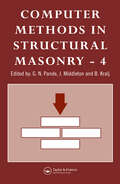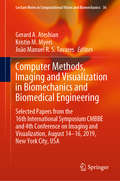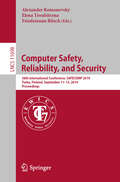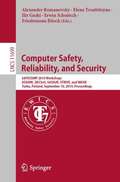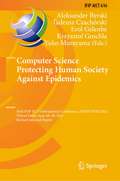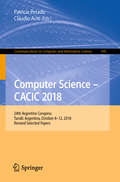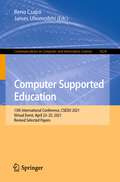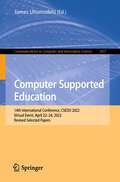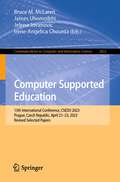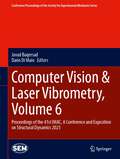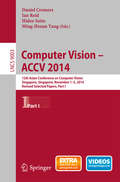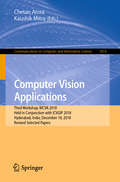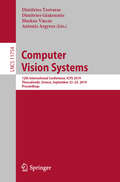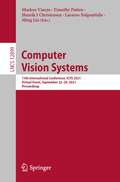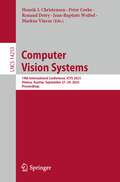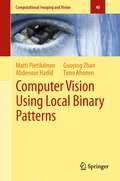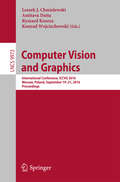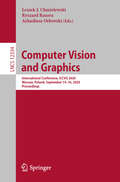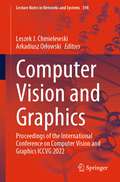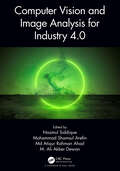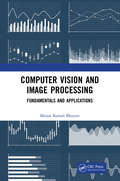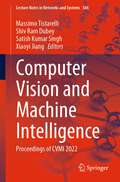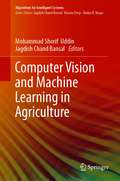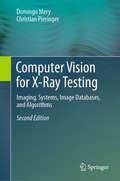- Table View
- List View
Computer Methods in Structural Masonry - 4: Fourth International Symposium
by J. Middleton G. N. Pande B. KraljThe proceedings of the fourth symposium on this topic examine the rapid advances and innovations being made in the theoretical and applied aspects of structural masonry. Focusing on the integration of computer modelling with experimental methods, assessment techniques, restoration and retro-fitting procedures, this is a thorough examination of the
Computer Methods, Imaging and Visualization in Biomechanics and Biomedical Engineering: Selected Papers from the 16th International Symposium CMBBE and 4th Conference on Imaging and Visualization, August 14-16, 2019, New York City, USA (Lecture Notes in Computational Vision and Biomechanics #36)
by João Manuel R. S. Tavares Gerard A. Ateshian Kristin M. MyersThis book gathers selected, extended and revised contributions to the 16th International Symposium on Computer Methods in Biomechanics and Biomedical Engineering, and the 4th Conference on Imaging and Visualization (CMBBE 2019), held on August 14-16, 2019, in New York City, USA. It reports on cutting-edge models and algorithms for studying various tissues and organs in normal and pathological conditions; innovative imaging and visualization techniques; and the latest diagnostic tools. Further topics addressed include: numerical methods, machine learning approaches, FEM models, and high-resolution imaging and real-time visualization methods applied for biomedical purposes. Given the scope of its coverage, the book provides graduate students and researchers with a timely and insightful snapshot of the latest research and current challenges in biomedical engineering, computational biomechanics and biological imaging, as well as a source of inspiration for future research and cross-disciplinary collaborations.
Computer Safety, Reliability, and Security: 38th International Conference, SAFECOMP 2019, Turku, Finland, September 11–13, 2019, Proceedings (Lecture Notes in Computer Science #11698)
by Alexander Romanovsky Friedemann Bitsch Elena TroubitsynaThis book constitutes the proceedings of the 38th International Conference on Computer Safety, Reliability and Security, SAFECOMP 2019, held in Turku, Finland, in September 2019. The 16 full and 5 short papers included in this volume were carefully reviewed and selected from 65 submissions. They were organized in topical sections named: formal verification; autonomous driving; safety and reliability modeling; security engineering and risk assessment; safety argumentation; verification and validation of autonomous systems; and interactive systems and design validation.
Computer Safety, Reliability, and Security: SAFECOMP 2019 Workshops, ASSURE, DECSoS, SASSUR, STRIVE, and WAISE, Turku, Finland, September 10, 2019, Proceedings (Lecture Notes in Computer Science #11699)
by Alexander Romanovsky Friedemann Bitsch Erwin Schoitsch Elena Troubitsyna Ilir GashiThis book constitutes the proceedings of the Workshops held in conjunction with SAFECOMP 2019, 38th International Conference on Computer Safety, Reliability and Security, in September 2019 in Turku, Finland. The 32 regular papers included in this volume were carefully reviewed and selected from 43 submissions; the book also contains two invited papers. The workshops included in this volume are: ASSURE 2019: 7th International Workshop on Assurance Cases for Software-Intensive Systems DECSoS 2019: 14th ERCIM/EWICS/ARTEMIS Workshop on Dependable Smart Embedded and Cyber-Physical Systems and Systems-of-Systems SASSUR 2019: 8th International Workshop on Next Generation of System Assurance Approaches for Safety-Critical Systems STRIVE 2019: Second International Workshop on Safety, securiTy, and pRivacy In automotiVe systEms WAISE 2019: Second International Workshop on Artificial Intelligence Safety Engineering
Computer Science Protecting Human Society Against Epidemics: First IFIP TC 5 International Conference, ANTICOVID 2021, Virtual Event, June 28–29, 2021, Revised Selected Papers (IFIP Advances in Information and Communication Technology #616)
by Erol Gelenbe Yuko Murayama Tadeusz Czachórski Krzysztof Grochla Aleksander ByrskiThis book constitutes the refereed post-conference proceedings of the First IFIP TC 5 International Conference on Computer Science Protecting Human Society Against Epidemics, ANTICOVID 2021, held virtually in June 2021.The 7 full and 4 short papers presented were carefully reviewed and selected from 20 submissions. The papers are concerned with a very large spectrum of problems, ranging from linguistics for automatic translation of medical terms, to a proposition for a worldwide system of fast reaction to emerging pandemic.
Computer Science – CACIC 2018: 24th Argentine Congress, Tandil, Argentina, October 8–12, 2018, Revised Selected Papers (Communications in Computer and Information Science #995)
by Patricia Pesado Claudio AcitiThis book constitutes revised selected papers from the 24th Argentine Congress on Computer Science, CACIC 2018, held in Tandil, Argentina, in October 2018. The 26 papers presented in this volume were carefully reviewed and selected from a total of 155 submissions. They were organized in topical sections named: Agents and Systems; Distributed and Parallel Processing; Technology Applied to Education; Graphic Computation, Images and Visualization; Software Engineering; Databases and Data Mining; Hardware Architectures, Networks, and Operating Systems; Innovation in Software Systems; Signal Processing and Real-Time Systems; Computer Security; Innovation in Computer Science Education; and Digital Governance and Smart Cities.
Computer Supported Education: 13th International Conference, CSEDU 2021, Virtual Event, April 23–25, 2021, Revised Selected Papers (Communications in Computer and Information Science #1624)
by James Uhomoibhi Beno CsapóThis book constitutes selected, revised and extended papers from the 13th International Conference on Computer Supported Education, CSEDU 2021, held as a virtual event in April 2021.The 27 revised full papers were carefully reviewed and selected from 143 submissions. They were organized in topical sections as follows: artificial intelligence in education; information technologies supporting learning; learning/teaching methodologies and assessment; social context and learning environments; ubiquitous learning; current topics.
Computer Supported Education: 14th International Conference, CSEDU 2022, Virtual Event, April 22–24, 2022, Revised Selected Papers (Communications in Computer and Information Science #1817)
by James UhomoibhiThis book constitutes the refereed post-proceedings of the 14th International Conference on Computer Supported Education, CSEDU 2022, Virtual Event, April 22–24, 2022. The conference was held virtually due to the COVID-19 crisis.The 8 full papers included in this book were carefully reviewed and selected from 181 submissions. The papers included in CSEDU 2022 proceedings contribute to the understanding of relevant trends of current research on Computer Supported Education, including: Emerging Technologies in Education for Sustainable Development, Instructional Design, Pre-K/K-12 Education, Machine Learning, Learning with AI Systems, Higher Order Thinking Skills, Game-Based and Simulation-Based Learning, Educational Data Mining, Course Design and eLearning Curriculae and Constructivism and Social Constructivism.
Computer Supported Education: 15th International Conference, CSEDU 2023, Prague, Czech Republic, April 21–23, 2023, Revised Selected Papers (Communications in Computer and Information Science #2052)
by James Uhomoibhi Bruce M. McLaren Irene-Angelica Chounta Jelena JovanovicThis book constitutes revised selected papers from the 15th International Conference on Computer Supported Education, CSEDU 2023, which took place in Prague, Czech Republic, during April 21–23, 2023.CSEDU 2023 accepted 34 full and 54 papers out of 162 papers submissions. Out of these, 8 contributions have been selected for inclusion in this book. The papers included in this book contribute to the understanding of relevant trends in the current research on Computer Supported Education, with a particular focus on: eLearning Platforms, Portals, Feedback and Learning Support, Game-Based and Simulation-Based Learning, Active Learning, Tools to Assess Learning, Learning with AI Systems, Higher Order Thinking Skills, Flipped Classroom, Faculty Development and Constructivism and Social Constructivism.
Computer Vision & Laser Vibrometry, Volume 6: Proceedings of the 41st IMAC, A Conference and Exposition on Structural Dynamics 2023 (Conference Proceedings of the Society for Experimental Mechanics Series)
by Dario Di Maio Javad BaqersadComputer Vision & Laser Vibrometry, Volume 6: Proceedings of the 41st IMAC, A Conference and Exposition on Structural Dynamics, 2023, the sixth volume of ten from the Conference brings together contributions to this important area of research and engineering. The collection presents early findings and case studies on fundamental and applied aspects of Computer Vision, Laser Vibrometry and Structural Health Monitoring, including papers on:Novel TechniquesOptical Methods,Scanning LDV MethodsPhotogrammetry & DICStructural Health Monitoring
Computer Vision -- ACCV 2014: 12th Asian Conference on Computer Vision, Singapore, Singapore, November 1-5, 2014, Revised Selected Papers, Part I (Lecture Notes in Computer Science #9003)
by Daniel Cremers Ian Reid Hideo Saito Ming-Hsuan YangThe five-volume set LNCS 9003--9007 constitutes the thoroughly refereed post-conference proceedings of the 12th Asian Conference on Computer Vision, ACCV 2014, held in Singapore, Singapore, in November 2014. The total of 227 contributions presented in these volumes was carefully reviewed and selected from 814 submissions. The papers are organized in topical sections on recognition; 3D vision; low-level vision and features; segmentation; face and gesture, tracking; stereo, physics, video and events; and poster sessions 1-3.
Computer Vision Applications: Third Workshop, WCVA 2018, Held in Conjunction with ICVGIP 2018, Hyderabad, India, December 18, 2018, Revised Selected Papers (Communications in Computer and Information Science #1019)
by Chetan Arora Kaushik MitraThis book constitutes the refereed proceedings of the third Workshop on Computer Vision Applications, WCVA 2018, held in Conjunction with ICVGIP 2018, in Hyderabad, India, in December 2018. The 10 revised full papers presented were carefully reviewed and selected from 32 submissions. The papers focus on computer vision; industrial applications; medical applications; and social applications.
Computer Vision Systems: 12th International Conference, ICVS 2019, Thessaloniki, Greece, September 23–25, 2019, Proceedings (Lecture Notes in Computer Science #11754)
by Markus Vincze Dimitrios Tzovaras Dimitrios Giakoumis Antonis ArgyrosThis book constitutes the refereed proceedings of the 12th International Conference on Computer Vision Systems, ICVS 2019, held in Thessaloniki, Greece, in September 2019.The 72 papers presented were carefully reviewed and selected from 114 submissions. The papers are organized in the following topical sections; hardware accelerated and real time vision systems; robotic vision; vision systems applications; high-level and learning vision systems; cognitive vision systems; movement analytics and gesture recognition for human-machine collaboration in industry; cognitive and computer vision assisted systems for energy awareness and behavior analysis; and vision-enabled UAV and counter UAV technologies for surveillance and security of critical infrastructures.
Computer Vision Systems: 13th International Conference, ICVS 2021, Virtual Event, September 22-24, 2021, Proceedings (Lecture Notes in Computer Science #12899)
by Lazaros Nalpantidis Ming Liu Markus Vincze Timothy Patten Henrik I ChristensenThis book constitutes the refereed proceedings of the 13th International Conference on Computer Vision Systems, ICVS 2021, held in September 2021. Due to COVID-19 pandemic the conference was held virtually. The 20 papers presented were carefully reviewed and selected from 29 submissions. cover a broad spectrum of issues falling under the wider scope of computer vision in real-world applications, including among others, vision systems for robotics, autonomous vehicles, agriculture and medicine. In this volume, the papers are organized into the sections: attention systems; classification and detection; semantic interpretation; video and motion analysis; computer vision systems in agriculture.
Computer Vision Systems: 14th International Conference, ICVS 2023, Vienna, Austria, September 27–29, 2023, Proceedings (Lecture Notes in Computer Science #14253)
by Peter Corke Henrik I. Christensen Markus Vincze Renaud Detry Jean-Baptiste WeibelThis volume LNCS 14253 constitutes the refereed proceedings of the 14th International Conference, ICVS 2023, in Vienna, Austria, in September 2023.. The 37 full papers presented were carefully reviewed and selected from 74 submissions. The conference focuses on Humans and Hands; Medical and Health Care; Farming and Forestry; Automation and Manufacturing; Mobile Robotics and Autonomous Systems; and Performance and Robustness.
Computer Vision Using Local Binary Patterns: Computer Vision Using Local Binary Patterns (Computational Imaging and Vision #40)
by Guoying Zhao Matti Pietikäinen Timo Ahonen Abdenour HadidThe recent emergence of Local Binary Patterns (LBP) has led to significant progress in applying texture methods to various computer vision problems and applications. The focus of this research has broadened from 2D textures to 3D textures and spatiotemporal (dynamic) textures. Also, where texture was once utilized for applications such as remote sensing, industrial inspection and biomedical image analysis, the introduction of LBP-based approaches have provided outstanding results in problems relating to face and activity analysis, with future scope for face and facial expression recognition, biometrics, visual surveillance and video analysis. Computer Vision Using Local Binary Patterns provides a detailed description of the LBP methods and their variants both in spatial and spatiotemporal domains. This comprehensive reference also provides an excellent overview as to how texture methods can be utilized for solving different kinds of computer vision and image analysis problems. Source codes of the basic LBP algorithms, demonstrations, some databases and a comprehensive LBP bibliography can be found from an accompanying web site. Topics include: local binary patterns and their variants in spatial and spatiotemporal domains, texture classification and segmentation, description of interest regions, applications in image retrieval and 3D recognition - Recognition and segmentation of dynamic textures, background subtraction, recognition of actions, face analysis using still images and image sequences, visual speech recognition and LBP in various applications. Written by pioneers of LBP, this book is an essential resource for researchers, professional engineers and graduate students in computer vision, image analysis and pattern recognition. The book will also be of interest to all those who work with specific applications of machine vision.
Computer Vision and Graphics: International Conference, ICCVG 2016, Warsaw, Poland, September 19-21, 2016, Proceedings (Lecture Notes in Computer Science #9972)
by Leszek J. Chmielewski Amitava Datta Ryszard Kozera Konrad WojciechowskiThis book constitutes the thoroughly refereed post-conference proceedings of the International Conference on Computer Vision and Graphics, ICCVG 2008, held in Warsaw, Poland, in November 2008. The 48 revised full papers presented were carefully reviewed and selected from numerous submissions. The papers are organized in topical sections on image processing, image quality assessment, geometrical models of objects and scenes, motion analysis, visual navigation and active vision, image and video coding, virtual reality and multimedia applications, biomedical applications, practical applications of pattern recognition, computer animation, visualization and graphical data presentation.
Computer Vision and Graphics: International Conference, ICCVG 2020, Warsaw, Poland, September 14–16, 2020, Proceedings (Lecture Notes in Computer Science #12334)
by Leszek J. Chmielewski Ryszard Kozera Arkadiusz OrłowskiThis book constitutes the refereed proceedings of the International Conference on Computer Vision and Graphics, ICCVG 2020, held in Warsaw, Poland, in September 2020. The 20 full papers were selected from 49 submissions. The contributions cover topics such as: modelling of human visual perception; computational geometry; geometrical models of objects and scenes; illumination and reflection models and methods; image formation; image and video coding; image filtering and enhancement; biomedical image processing; biomedical graphics; colour image processing; multispectral image processing; pattern recognition in image processing; scene understanding; motion analysis, visual navigation and active vision; human motion detection and analysis; visualisation and graphical data presentation; hardware and architectures for image processing; computer-aided graphic design; 3D imaging, shading and rendering; computer animation; graphics for internet and mobile systems; virtual reality; image and video databases; digital watermarking; multimedia applications; and computer art. Due to the Corona pandemic ICCVG 2020 was held as a virtual event.
Computer Vision and Graphics: Proceedings of the International Conference on Computer Vision and Graphics ICCVG 2022 (Lecture Notes in Networks and Systems #598)
by Leszek J. Chmielewski Arkadiusz OrłowskiThis book contains 17 papers presented at the conference devoted to cutting-edge technologies and concepts related to image processing. A broad collection of problems including man–machine interfaces, comparison of quantum and conventional computing in deep learning, medical image processing, image segmentation, face recognition, outdoor scene analysis, image rendering and colorization, map generation, traffic analysis, hardware acceleration, data association, and visual cryptography is investigated.Research on these issues is important, among others due to that large amounts of video data are collected continually. They can be easily stored, but their analysis is still a challenge.The book is primarily intended for researchers and practitioners in image analysis and generation, as well as for students in the fields related to computer science. However, any reader interested in the subject matter of the book will find some chapters interesting and valuable.
Computer Vision and Image Analysis for Industry 4.0
by Nazmul Siddique Mohammad Shamsul Arefin Ahad, Md Atiqur Rahman Dewan, M. Ali AkberComputer vision and image analysis are indispensable components of every automated environment. Modern machine vision and image analysis techniques play key roles in automation and quality assurance. Working environments can be improved significantly if we integrate computer vision and image analysis techniques. The more advancement in innovation and research in computer vision and image processing, the greater the efficiency of machines as well as humans. Computer Vision and Image Analysis for Industry 4.0 focuses on the roles of computer vision and image analysis for 4.0 IR-related technologies. The text proposes a variety of techniques for disease detection and prediction, text recognition and signature verification, image captioning, flood level assessment, crops classifications and fabrication of smart eye-controlled wheelchairs.
Computer Vision and Image Processing: Fundamentals and Applications
by Manas Kamal BhuyanThe book familiarizes readers with fundamental concepts and issues related to computer vision and major approaches that address them. The focus of the book is on image acquisition and image formation models, radiometric models of image formation, image formation in the camera, image processing concepts, concept of feature extraction and feature selection for pattern classification/recognition, and advanced concepts like object classification, object tracking, image-based rendering, and image registration. Intended to be a companion to a typical teaching course on computer vision, the book takes a problem-solving approach.
Computer Vision and Machine Intelligence: Proceedings of CVMI 2022 (Lecture Notes in Networks and Systems #586)
by Xiaoyi Jiang Massimo Tistarelli Satish Kumar Singh Shiv Ram DubeyThis book presents selected research papers on current developments in the fields of computer vision and machine intelligence from International Conference on Computer Vision and Machine Intelligence (CVMI 2022). The book covers topics in image processing, artificial intelligence, machine learning, deep learning, computer vision, machine intelligence, etc. The book is useful for researchers, postgraduate and undergraduate students, and professionals working in this domain.
Computer Vision and Machine Learning in Agriculture (Algorithms for Intelligent Systems)
by Jagdish Chand Bansal Mohammad Shorif UddinThis book discusses computer vision, a noncontact as well as a nondestructive technique involving the development of theoretical and algorithmic tools for automatic visual understanding and recognition which finds huge applications in agricultural productions. It also entails how rendering of machine learning techniques to computer vision algorithms is boosting this sector with better productivity by developing more precise systems. Computer vision and machine learning (CV-ML) helps in plant disease assessment along with crop condition monitoring to control the degradation of yield, quality, and severe financial loss for farmers. Significant scientific and technological advances have been made in defect assessment, quality grading, disease recognition, pests, insects, fruits, and vegetable types recognition and evaluation of a wide range of agricultural plants, crops, leaves, and fruits. The book discusses intelligent robots developed with the touch of CV-ML which can help farmers to perform various tasks like planting, weeding, harvesting, plant health monitoring, and so on. The topics covered in the book include plant, leaf, and fruit disease detection, crop health monitoring, applications of robots in agriculture, precision farming, assessment of product quality and defects, pest, insect, fruits, and vegetable types recognition.
Computer Vision for Visual Effects
by Richard J. RadkeModern blockbuster movies seamlessly introduce impossible characters and action into real-world settings using digital visual effects. These effects are made possible by research from the field of computer vision, the study of how to automatically understand images. Computer Vision for Visual Effects will educate students, engineers, and researchers about the fundamental computer vision principles and state-of-the-art algorithms used to create cutting-edge visual effects for movies and television. The author describes classical computer vision algorithms used on a regular basis in Hollywood (such as blue screen matting, structure from motion, optical flow, and feature tracking) and exciting recent developments that form the basis for future effects (such as natural image matting, multi-image compositing, image retargeting, and view synthesis). He also discusses the technologies behind motion capture and three-dimensional data acquisition. More than 200 original images demonstrating principles, algorithms, and results, along with in-depth interviews with Hollywood visual effects artists, tie the mathematical concepts to real-world filmmaking.
Computer Vision for X-Ray Testing: Imaging, Systems, Image Databases, and Algorithms
by Domingo Mery Christian Pieringer[FIRST EDITION] This accessible textbook presents an introduction to computer vision algorithms for industrially-relevant applications of X-ray testing. Features: introduces the mathematical background for monocular and multiple view geometry; describes the main techniques for image processing used in X-ray testing; presents a range of different representations for X-ray images, explaining how these enable new features to be extracted from the original image; examines a range of known X-ray image classifiers and classification strategies; discusses some basic concepts for the simulation of X-ray images and presents simple geometric and imaging models that can be used in the simulation; reviews a variety of applications for X-ray testing, from industrial inspection and baggage screening to the quality control of natural products; provides supporting material at an associated website, including a database of X-ray images and a Matlab toolbox for use with the book’s many examples.
